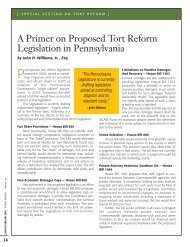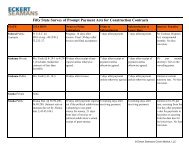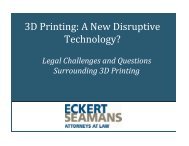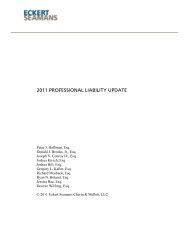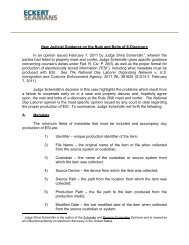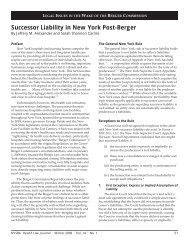deviated from any professional standard, which would mandate the filing of a certificate of merit.The court examined Section 522 of the Restatement (Second) of Torts, which Pennsylvania hasadopted “to clarify the tort of negligent misrepresentation as it applies to those in the business ofsupplying information where it is foreseeable that the information will be relied on by thirdparties.” The court opined that “the tort will serve the overall public interest by discouragingnegligence among design professionals, while not requiring any more of them than is required bythe traditional reasonable man and foreseeability tort paradigm applicable to others.” The courtheld, the tort of negligent misrepresentation does not require expert testimony because theapplicable standard of care is the traditional reasonable man standard. Thus, a certificate ofmerit is not needed to support a claim of negligent misrepresentation against a designprofessional.In Stroud v. Abington Memorial Hospital, 546 F. Supp. 2d. 238, (E.D. Pa. 2008), theCourt examined whether an entry of judgment of non pros for a corporate negligence claimagainst a hospital was proper, where Plaintiff only filed a timely certificate of merit setting forthclaims of vicarious liability against the hospital. The court explained that while Plaintiff filed anamended certificate of merit, supporting the corporate negligence claims, this certificate of meritwas filed after the defendant hospital filed a motion to dismiss (which is the federal mechanismfor enforcing the failure to file a certificate of merit). The court found that Plaintiff had properlypleaded a claim of corporate negligence against the hospital, but Plaintiff’s certificate of meritsupporting a corporate negligence claim was filed more than sixty days after the filing of theComplaint and after Defendant’s motion to dismiss. The Court held Plaintiff did not file a timelycertificate of merit regarding the corporate negligence claim, and the claim would be dismissedunless Plaintiff could establish a reasonable explanation or legitimate excuse for not timely filinga certificate of merit. The court granted Plaintiff’s corporate negligence claim without prejudice,and allowed Plaintiff leave to seek reinstatement to present evidence of a reasonable explanationor legitimate excuse for not filing the certificate of merit.In Pollock v. Feinstein, 1 Pa. D. & C.5th 38 (Phila. Cty. Ct. Com. Pl. Mar. 28, 2006),aff’d, 917 A.2d 875 (Pa. Super. Ct. 2007), Plaintiff brought suit against her physician aftersustaining a laceration to her anterior abdominal wall during a laparoscopic tubal ligation andIUD removal. Plaintiff claimed that Defendant failed to provide her with material informationregarding the procedure, such as risks, consequences and alternatives necessary for her todetermine whether to proceed with the surgery, and that Defendant was therefore negligent forfailing to obtain her conformed consent.In response, Defendants argued that failing to obtain informed consent constitutes adeviation from acceptable medical standards, and that Plaintiff was therefore required to file acertificate of merit in order to maintain her cause of action. Given that Plaintiff failed to timelyfile a certificate of merit, in turn, Defendant moved for the entry of a judgment of non pros.Plaintiff countered by arguing that she was not required to file a certificate of merit because hermalpractice action was based solely on lack of informed consent. The court, in turn, wasconfronted with the question of whether “a claim for lack of informed consent constitutes adeviation from ‘an acceptable professional standard’ warranting the filing of a certificate of meritpursuant to the rules of civil procedure.”124
The Court of Common Pleas ultimately ruled in favor of Defendant, analyzing thedoctrine of informed consent under Pennsylvania law and holding that,[a] medical provider complie[s] with the consent requirements ifhe or she disclose[s] risks and alternatives in accordance withacceptable medical standards. Hence . . . a claim of lack ofinformed consent falls within the boundaries of Pa.R.C.P. §1042.3(a). As such, a Certificate of Merit is required.Plaintiff appealed to the Superior Court, 917 A.2d 875 (Pa. Super. Ct. 2007). On appeal,the court affirmed the lower court’s decision. The court explained that “[a]t its core, this actionrequired a showing that [defendants] failed to conform to a specific acceptable professionalstandard, namely ‘[to] provide patients with material information necessary to determine whetherto proceed with the surgical or operative procedure, or to remain in the present condition.’”Thus, the trial court correctly found that a Rule 1042.3 certificate of merit was required for aclaim of lack of informed consent.(ii)Applicability of Federal and State Law in FederalCourtIn Liggon-Redding v. Estate of Robert Sugarman, 659 F. 3d 258 (3 rd Cir. 2011),infra, the Third Circuit held definitively that Pennsylvania Rule of Civil Procedure 1042.3,mandating a certificate of merit in professional negligence cases, is substantive law andmust be applied by federal courts.In Everett v. Donate, 2010 WL 1052944, * 3 (M.D. Pa. Mar. 22, 2010), aff’d, 397 Fed.Appx. 744, (3d Cir. 2010) the court addressed whether it was required to apply Rule 1042.3when it was not sitting in diversity and was instead addressing pendent state claims ofnegligence. The court cited to Abdulhay v. Bethlehem Medical Arts, 2005 WL 2416012 (E.D.Pa. Sept. 28, 2010), and held that under the Erie doctrine, “federal courts must apply [Rule1042.3] to state law claims arising under pendent jurisdiction.” Id. The court also noted thatplaintiff’s incarceration or pro se status is not a viable excuse for plaintiff’s failure to complywith Rule 1042.3. Id. at *4. The court further noted that Rule 1042.3 does not require that themoving party allege it suffered prejudice by plaintiff’s failure to file a certificate of merit. Id.Iwanejko v. Cohen & Grigsby, P.C., 249 Fed. Appx. 938 (3d. Cir. 2007) (notprecedential), involved an attorney, who had a psychotic breakdown at work. He wasinvoluntarily committed to a mental health center. After a brief stay, Plaintiff attorney returnedto work subject to a work agreement, but was subsequently terminated for violating theagreement. Plaintiff filed suit against multiple Defendants, including the mental health center.Defendant filed a motion to dismiss based upon Plaintiff’s failure to file a certificate of merit andthe trial court dismissed Plaintiff’s claims against the mental health center. On appeal, Plaintiffargued that his claim did not invoke Rule 1042.3. Additionally, Plaintiff maintained thatDefendant waived the certificate of merit defense by failing to raise it in a previous Rule 12(b)(6)motion.125
- Page 3 and 4:
EMTALA CASES ......................
- Page 5:
Filing an Affidavit of Non-Involvem
- Page 8 and 9:
II.PROFESSIONAL LIABILITY - AN OVER
- Page 10 and 11:
The Superior Court reversed the tri
- Page 12 and 13:
to a third party pursuant to the st
- Page 14 and 15:
After approximately five months, De
- Page 16 and 17:
learned the day after the surgery t
- Page 18 and 19:
conduct to the delay in colon cance
- Page 20 and 21:
court admitted the expert’s testi
- Page 22 and 23:
(b)(c)other reasonable causes, incl
- Page 24 and 25:
corroborated his testimony. The cou
- Page 26 and 27:
husband’s estate. Plaintiff alleg
- Page 28 and 29:
Other notable federal cases arising
- Page 30 and 31:
The Superior Court found that in re
- Page 32 and 33:
§ 1303.512(b). The court, however,
- Page 34 and 35:
In Neidig v. United States, No. 07-
- Page 36 and 37:
Additionally, the Supreme Court not
- Page 38 and 39:
were not indicated for her conditio
- Page 40 and 41:
surgeon is the same as it would be
- Page 42 and 43:
It should be noted that the Superio
- Page 44 and 45:
Finally, the court held that the tr
- Page 46 and 47:
The Supreme Court of Pennsylvania r
- Page 48 and 49:
nurses deviating from applicable st
- Page 50 and 51:
certainty, the court reviews expert
- Page 52 and 53:
Under Pennsylvania law, the Court n
- Page 54 and 55:
testimony, Defendant presented his
- Page 56 and 57:
Following Cooper v. Roberts, 286 A.
- Page 58 and 59:
Plaintiff developed chronic diarrhe
- Page 60 and 61:
where payment is made by Medicaid w
- Page 62 and 63:
accomplished. In Valles v. Albert E
- Page 64 and 65:
In 1980, the Pennsylvania Superior
- Page 66 and 67:
Plaintiff had a routine monitoring
- Page 68 and 69:
Plaintiff’s Contract ClaimsThe Co
- Page 70 and 71:
is a failure to report changes in a
- Page 72 and 73:
unit to assure post-surgical patien
- Page 74 and 75:
sliced his wrist and arm with a raz
- Page 76 and 77:
licensed professionals for whom the
- Page 78 and 79:
(c)Limitations of Corporate Neglige
- Page 80 and 81: Even more recently, our Superior Co
- Page 82 and 83: (a)HMO IssuesIn McClellan v. Health
- Page 84 and 85: affidavit submitted by Defendants o
- Page 86 and 87: treatments while at VA’s faciliti
- Page 88 and 89: [s]ubstantively, we believe that a
- Page 90 and 91: The party claiming the benefit of t
- Page 92 and 93: deprive (him) of civil rights guara
- Page 94 and 95: found that the District Court was w
- Page 96 and 97: With respect to fraudulent concealm
- Page 98 and 99: would be applied in situations wher
- Page 100 and 101: they had not raised them in the cou
- Page 102 and 103: (a)Informed ConsentUnder MCARE, a p
- Page 104 and 105: civil enforcement provisions and ma
- Page 106 and 107: MCARE also changes the manner in wh
- Page 108 and 109: whose death, in 2005, was allegedly
- Page 110 and 111: vicariously liable if the plaintiff
- Page 112 and 113: health center or its equivalent or
- Page 114 and 115: In Pennsylvania Medical Society, th
- Page 116 and 117: to any professional who is alleged
- Page 118 and 119: Since the 2005 amendments, there ha
- Page 120 and 121: ule, but who intentionally ignores
- Page 122 and 123: the original Complaint was delivere
- Page 124 and 125: foreclose all challenges against th
- Page 126 and 127: number of boxes), which was support
- Page 128 and 129: questions of professional judgment
- Page 132 and 133: The Third Circuit affirmed the Dist
- Page 134 and 135: claims and cross-claims remain agai
- Page 136 and 137: By an Amendatory Order dated March
- Page 138 and 139: The court acknowledged that there i
- Page 140 and 141: apply and that the trial court misa
- Page 142 and 143: Barbados had enough litigation-spec
- Page 144 and 145: E. Preemption of Vaccine Design Def
- Page 146 and 147: 2. Pa. R. Civ. Pro. 1036.1 - Reinst
- Page 148 and 149: Barrick, at *34-35.Furthermore, the
- Page 150 and 151: (b) the utility of the defendant’
- Page 152 and 153: 2006). In this case, Plaintiffs bro
- Page 154 and 155: B. Elements of a Cause of Action fo
- Page 156 and 157: decision in Muhammad precluded Mr.
- Page 158 and 159: considered speculative “only if t
- Page 160 and 161: underlying cause of action involved
- Page 162 and 163: In Capital Care Corp., the Superior
- Page 164 and 165: The court found, however, to state
- Page 166 and 167: of reasonable diligence. The standa
- Page 168 and 169: not be set aside. On July 7, 2005,
- Page 170 and 171: complete bar to recovery. Since a l
- Page 172 and 173: On appeal, Plaintiffs claimed that
- Page 174 and 175: In Liggon-Redding, 659 F.3d at 265,
- Page 176 and 177: elieved of those minimum standards
- Page 178 and 179: elevant to the proceedings, the com
- Page 180 and 181:
establish professional misconduct b
- Page 182 and 183:
Upholding the Superior Court’s Or
- Page 184 and 185:
Id.Rejecting revocation and suspens
- Page 186 and 187:
order as a sanction under Rule 4019
- Page 188:
{1009912]182



